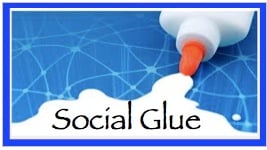Recent polling indicates that 78.2% (+/-3% correct) of business mistakes are the result of meetings. I’m not serious, but my serious experience is that a high percentage of business mistakes come from meetings. Mistakes come from meetings where facts and details are withheld, incomplete, or left unstated and from meetings where status is reported and questions are few, where opportunities are mentioned but not fully explored, and where individual work is valued over collaboration.
Most meetings are designed to be left-brain thinking – order, logic, linear events, etc. – and only require half our brainpower, the left half. The right brain, our creative side, moves into idle in many of these meetings. To get whole-brain thinking and creatively engage team brainpower in meetings, you should apply social glue. Social glue consists of activities or interactions that strengthen the relational ties in a group of people, and you should leverage this little used resource to bond the best ideas to business solutions.
Recently, 78% of workers surveyed by the Kensington Technology Group said that stress forces them to make mistakes on the job. The human reaction to stress can be as many as 1,500 separate body changes – and, it’s been proven that this affects virtually every major organ system of your body. This high number of negative body changes to your important resource of people is unacceptable – and potentially a business killer. By utilizing idea creation (ideation) processes with your team, you’ve begun to formulate the social glue that cultivates an environment coveted by recruits versus one where team members keep their resumé handy (and recruits keep their distance).
Consider everything from free to expensive options, and those requiring small to major time investments. In working with leaders from Wow Factor Cakes to Walmart, Disney Imagineering to DHL Worldwide, and a host of medium size businesses in between, I’ve seen that the best teams execute well and think creatively.
If you’re falling short of creative business ideas, below are the basics that I’ve seen used with teams to create the social glue that binds business with creative solutions:
First – Define the challenge.
A clearly defined problem is the key to effective group problem solving and creative thinking. It should describe the difference between WHAT WE WANT (the goal) and WHAT IS (the current situation). Your definition should contain an object, a defect or challenge, any clarifiers needed, etc. Once defined, administer this test: Project your defined problem into the future as if solved. Now ask yourself, “Do I have any other issues with this problem/challenge?” The answer “No“ means you have the correct definition. “Yes” means that you must work on further problem definition.
Second - Choose an approach.
There are literally dozens of creative approaches, and I don’t propose an all-encompassing list. I do recommend that you consider the ones below, add your own from other sources, and try something different. Here are a few of the solutions that have worked for me on multiple continents in a mix of cultures:
- "Free forming.” Start with your defined problem and ask a question, propose an idea, or submit a possible solution. Ask participants to write down one idea on the topic. Have them pass their paper to another participant to add to the idea. Continue until you are satisfied all ideas are on the table. I personally prefer starting with questions because it automatically turns your mind on to find a solution. Have you ever seen someone you knew only to forget his or her name? You may have stood there uncomfortably and then, walked away scratching your head, “what was his/her name?” That evening while having dinner there it is …her name was Sonja! Studies indicate that this happens because you asked your brain the question, and the brain will work until it finds the answer. Find creative answers and solutions by free forming questions more than ideas or answers.
- Investigate how other industries, companies, departments or project teams are operating and solving problems. Sometimes the best solutions come from a company or department that does not do what your team does.
- When meetings bog down, change your pace and do something completely different. In presentation skills, we recommend changing pace or focus every 5-10 minutes minimum. When planning how to lead a meeting, you can change focus from whiteboard to smart TV to flipchart to video to written answers to Q&A, etc.
- Reverse the problem. Looking at the opposite may help you find hidden solutions. For example, brainstorm ways to decrease sales or productivity for your organization. Discover your counter-productive practices.
- Realize that “sleep on it" is still appropriate in today’s "I need it now” society. Assign an idea for team members to take home and sleep on. Ask each member to write it down and "talk" to self just before going to sleep. Remind them that a question is more powerful than statement since the subconscious will immediately begin to search for the answer. Think of the problem as a question (i.e., In what ways can we...) prior to going to sleep. Supply a notebook to record thoughts so nothing is lost.
- Use an "idea board.” At a convenient location, use a whiteboard for people to record ideas/suggestions. At the top, list the problem, challenge, or solution that you need. Before they write ideas, request that they read others to eliminate duplication.
- Change meeting routine. Meetings are for communication, collaboration and results. Once your meetings become bogged down and boring, consider why. Are you allowing one meeting to become another? Examples include rewriting annual plans during quarterly planning meetings, or allowing a Daily Huddle to run into an hour-long meeting because one member has a stuck, or allowing two of five people to dominate meeting time with an issue that should be taken offline. Additionally, rotate facilitation of your meetings. This generally results in one of two things, 1) they do a great job, gain confidence and everyone learns, or 2) they don’t do well and then better respect the facilitation efforts of others. I find that either way they are generally better meeting participants afterwards.
- Laughter makes us more creative so include fun in your quest for creativity – but remember, never allow fun at the expense of someone else. This is the solvent that breaks down your social glue and should be immediately avoided. Fun is a natural social glue, and having fun can still be safe and productive.
Still Can’t Get Started?
Before you can get a breakthrough idea, you need a solid starting point for strategic thinking. If you’re not exactly sure what you’re looking for, take time to do the following:
- Make a list to help you concentrate and to help you see it from others’ viewpoints. Try listing the attributes (characteristics, parts, or dimensions), and then focus your attention on each attribute in turn. For example, one Swedish tool company decided to focus on the common screwdriver. They discovered that most people used both hands to turn the screwdriver even though the handle wasn’t designed for it. They developed the Ergo Screwdriver that has space for both hands. This idea was expanded to their entire tool line, which dramatically increased their market share in Europe. Some of the attributes that they might have listed include round, steel shaft, wooden or plastic handle, wedge-shaped tip, manually operated, operated by a twisting action or motion.
- Next, select what you feel are the most significant or unique attributes. Attempt to work with a manageable number, often around three to six.
- For each attribute, write down any ideas you have on how to improve or change it. Keep asking, “How else can this be accomplished?” or “Why does this have to be done this way?”
Who knows where getting started will take you, you might end up inventing something like an electric screwdriver with a super flexible shaft that can reach things positioned at an odd angles.
As a leader you face numerous pressures in the marketplace, like new technologies introduced every day (at breakneck speed), global markets that dominate production cycles, a diverse workforce with changing values and expectations, and as the world shrinks from technology, our business competition continues to increase.
Pablo Picasso once said, “Every act of creation begins with an act of destruction.”
May your success be a result of destroying creativity-busters and the bonding of social glue for continued business growth!



